
Florissant is a city in St. Louis County, Missouri, within Greater St. Louis. It is a middle-class, second-ring northern suburb of St. Louis. Based on the 2020 United States census, the city had a total population of 52,533.
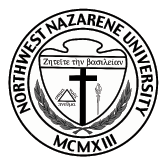
Northwest Nazarene University (NNU) is a private Nazarene university in Nampa, Idaho.
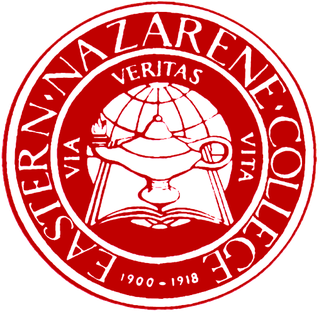
The Eastern Nazarene College (ENC) is a private, Christian college in Quincy, Massachusetts. Established as a holiness college in Quincy, Massachusetts, in 1900, the college moved to Rhode Island for several years. With its expansion to a four-year curriculum, it relocated to Wollaston Park in 1919. It has expanded to additional sites in Quincy and, since the late 20th century, to satellite sites across the state. Its academic programs are primarily undergraduate, with some professional graduate education offered.
Henry Orton Wiley was a Christian theologian primarily associated with the followers of John Wesley who are part of the Holiness movement. A member of the Church of the Nazarene, his "magnum opus" was the three volume systematic theology Christian Theology.

The Josiah Quincy House, located at 20 Muirhead Street in the Wollaston neighborhood of Quincy, Massachusetts, was the country home of Revolutionary War soldier Colonel Josiah Quincy I, the first in a line of six men named Josiah Quincy that included three Boston mayors and a president of Harvard University.

University, Hayes and Orton Halls are three historic buildings on the Oval at the Ohio State University in Columbus, Ohio. On July 16, 1970, they were added to the National Register of Historic Places. The original University Hall was demolished in 1971, and removed from the National Register that year.
Mildred Olive Bangs Wynkoop was an ordained minister in the Church of the Nazarene, who served as an educator, missionary, theologian, and the author of several books. Donald Dayton indicates that "Probably most influential for a new generation of Holiness scholars has been the work of Nazarene theologian Mildred Bangs Wynkoop, especially her book A Theology of Love: The Dynamic of Wesleyanism." The Wynkoop Center for Women in Ministry located in Kansas City, Missouri, is named in her honour. The Timothy L. Smith and Mildred Bangs Wynkoop Book Award of the Wesleyan Theological Society also jointly honours her "outstanding scholarly contributions."
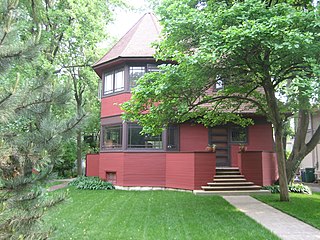
The Robert P. Parker House is a house located in the Chicago suburb of Oak Park, Illinois, United States. The house was designed by American architect Frank Lloyd Wright in 1892 and is an example of his early work. Real-estate agent Thomas H. Gale had it built and sold it to Robert P. Parker later that year. The house was designed by Wright independently while he was still employed by the firm Adler & Sullivan, run by engineer Dankmar Adler and architect, Louis Sullivan; taking outside commissions was something that Sullivan forbade. The Parker House is listed as a contributing property to a U.S. federally Registered Historic District.
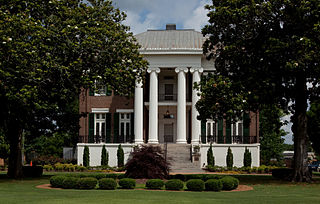
Rogers Hall, also known as Courtview, is a three-story antebellum house at 500 Court Street in Florence, Alabama. It was built by enslaved people from 1854 to 1855. It is one of the oldest historic landmarks on the University of North Alabama campus and one of the university's most distinctive structures. The building was recorded by the Historic American Buildings Survey from 1934–35. It was listed on the National Register of Historic Places on June 13, 1974.

Edgecliff College was a private Catholic women's college located in Cincinnati. It was founded in 1935 and merged with Xavier University, also of Cincinnati, in 1980.
William Wallace Anderson was a medical doctor who graduated from the University of Pennsylvania in 1846 with a Bachelor of Arts and the University of Pennsylvania School of Medicine in 1849. He was also involved in the architecture of rammed earth construction in South Carolina. He was the son of American Revolutionary War hero Richard Anderson and father of Confederate General Richard H. Anderson.
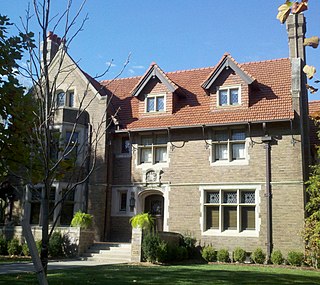
The Brandeis–Millard House is located in the West Farnam neighborhood, which is part of the Gold Coast Historic District in Midtown Omaha, Nebraska. Its carriage house is located at 3815 Dewey Avenue in the same area. Listed on the National Register of Historic Places in 1980, it was designated an Omaha Landmark on June 10, 1986.
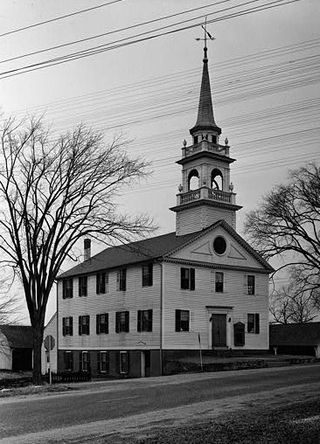
Preston City is a village and the original town center of the town of Preston, Connecticut. The core of the village around the junction of Old Northwest Road and Route 164 is designated as the Preston City Historic District, a historic district that is listed on the National Register of Historic Places. The district is located along Old Shetucket and Amos Roads, which, prior to the 1930s, were major thoroughfares.

Olive May Winchester (1879–1947) was an American ordained minister and a pioneer biblical scholar and theologian in the Church of the Nazarene, who was in 1912 the first woman ordained by any trinitarian Christian denomination in the United Kingdom, the first woman admitted into and graduated from the Bachelor of Divinity course at the University of Glasgow, and the first woman to complete a Doctor of Theology degree from the divinity school of Drew University.

The Leicester Meeting House is a historic church building at the junction of United States Route 7 and the Leicester-Whiting Road in the center of Leicester, Vermont. Built in 1829, it is a well-preserved example of vernacular Federal period church architecture executed in brick. It was listed on the National Register of Historic Places in 1988.

The Wonderland Trail is an approximately 93-mile (150 km) hiking trail that circumnavigates Mount Rainier in Mount Rainier National Park, Washington, United States. The trail goes over many ridges of Mount Rainier for a cumulative 22,000 feet (6,700 m) of elevation gain. The trail was built in 1915.
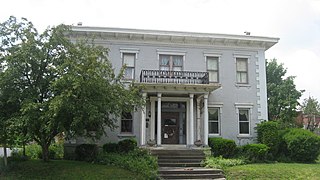
Samuel Purviance House, also known as Nazarene Annex, is a historic home located at Huntington, Huntington County, Indiana. It was built in 1859, and is a two-story, five bay, Italianate style brick dwelling with a 1+1⁄2-story rear ell. It sits on a cut stone foundation and has a flat roof. The front facade features an entrance portico with Gothic style columns. The house was purchased by the Church of the Nazarene in 1960.

The Edward Wells House is a historic house at 61 Summit Street in Burlington, Vermont. Built in 1891–92 for the president of a patent medicine maker, it is one of the city's finest examples of Queen Anne Victorian architecture executed in brick and stone. It was listed on the National Register of Historic Places in 1979. The house was for many years home to the Delta Psi fraternity; is now owned by the University of Vermont.
The House at 916 Preston Avenue in Thompson Falls, Montana was built in 1911–12. It was listed on the National Register of Historic Places in 1986.
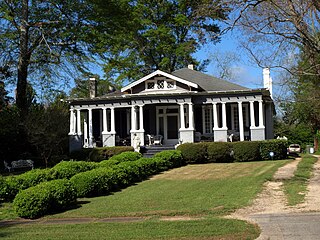
The Fort Dale-College Street Historic District is a historic district in Greenville, Alabama. The district contains Greenville's oldest existing affluent residences, dating to as early as the 1850s. In the initial federal land sale following the Creek War, the area that became northwest Greenville was claimed by William Dunklin. Dunklin sold the claim to William Burnette, who began to parcel the land for sale and to give to family members. Burnette's daughter and son-in-law built a Corinthian-columned Greek Revival home in 1857. A few other pre-Civil War houses remain, and construction continued after the war, including a school building that was later converted into a house. Most of the early residences were large, and built in Greek Revival, Second Empire, and Colonial Revival styles. Beginning in the 20th century, bungalows and cottages on smaller lots began to emerge. One of the later constructions in the district is a Spanish Colonial Revival house, built in 1928.


















